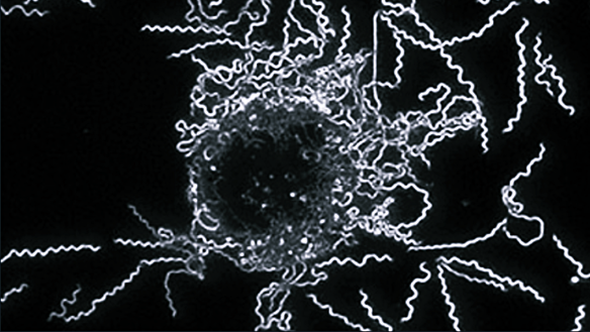spirochetes on the brain
May 13, 2008 in Science/Research by Dr. Robert C. Bransfield, MD
To know Lyme disease is to know medicine, neurology, psychiatry, ecology, law, politics, and ethics. Clearly this disease is too complex for any one individual to possess such abroad range of expertise.
My perspective is that of a psychiatrist in private practice in a Lyme endemic area. For many years, I noticed a significant number of Lyme disease patients complaining of sleep disorders, depression, and a number of other central nervous system (CNS) complaints. Whenever the sleep disorder and other psychiatric symptoms were effectively treated, often there was an improvement in the Lyme disease symptoms.
With time, I began to better appreciate the wide range of cognitive, psychiatric, neurological, and somatic symptoms that were a part of Lyme disease.
One such patient led to my greater involvement with Lyme disease. She had been previously diagnosed with the disease, and was treated with the usual protocol that was considered curative. Following her for several years, I found her mental status to follow a malignant downhill course, in spite of every psychotherapeutic treatment possible. Apart from the headaches, joint pain, cognitive impairments, etc., it was the mood swings, homicidal, and suicidal tendencies that were the most threatening symptoms. An extended period of IV antibiotics were clearly lifesaving, and she significantly improved. This case was subsequently published with Dr. Fallon in Psychosomatics.
Overtime, I have seen hundreds of Lyme disease patients with a broad range of symptoms affecting CNS functioning. After seeing how Lyme disease causes psychiatric, cognitive, and other neurological symptoms, it certainly raises the question - How much CNS disease is caused in some way by infectious disease?
Borrelia burgdorferi (Bb) is a major, but not the only causative agent. The greater issue is whether an active infectious process exists, the second issue is which infectious agent(s)? Very consistently, most of these neuropsychiatric patients show CNS herxheimer reactions followed by improvement in response to antibiotic treatments.
Let's step away from clinical observation, and instead look at disease from a more abstract view. Darwinian medicine looks at causes of disease from an evolutionary perspective. One view is that microbes evolve faster than humans and, as a result, infectious disease will always exist. What is the greatest predator of man? Lions, tigers, bears, white sharks, serial killers? No,microbes. When we consider how effective evolution has been, why is there so much disease?
The National Comorbidity Study shows 48% of the population suffers from a mental disorder at some point in their lives. Why is there so much mental illness? Most disease is a result of a unique combination of a vulnerability and an environmental circumstance.
One theory is that we are genetically adapted to stone age life, but are living in a very different environment. Such a view has complex implications, and can readily explain problems such as fear of flying. However, some other mental illness appears to be a failure of regulatory systems as a result of some type of neural injury, and dysfunction from infectious disease.
Currently there is a considerable recognition and research in the role of infectious disease in some of the common mental disorders. In addition to Bb, other infectious diseases such as strep, syphilis, AIDS, toxoplasmosis, and other infectious agents are recognized to cause psychiatric illness. The tentative conclusion of this research is - infectious disease causes a significant amount of mental illness.
There are several mechanisms by which neural dysfunction can occur from Bb - cerebral vasculitis, Bb attachment and penetration into nerve cells, excitotoxicity, incorporation of Bb DNA into host cell DNA causing auto immune disease, etc.
When infectious disease causes neural dysfunction, it is relatively easy to see the causal relationship associated with injury to the peripheral nervous system, autonomic nervous system, endocrine system, and the gray matter of the cerebral cortex. Brain stem/mid brain injury results in dysfunction of vegetative modulation systems. Cerebral cortex white matter and sub cortical dysfunction is associated with specific processing impairments. However, dysfunction of the limbic and para limbic systems is the most challenging to understand.
To look at the basic structure of the limbic system, it is an emotional modulation center. Injury can result in a failure of an ability to evoke or inhibit an emotional function. The end result can be disorders such as depression, panic, OCD, mania, hallucinations, apathy, etc.
The cognitive and processing dysfunction is much easier to correlate with anatomy and physiology. For example, prefrontal cortex dysfunction correlates with executive function and attention span deficits, and can be demonstrated on SPECT and PET. Some deficits are correlated with very specific areas of the brain, while other dysfunction, such as violence, can correlate with injury in many different areas.
Any standard of diagnosis for late stage, chronic Lyme disease must incorporate the fact that it is a very complex disease with not only CNS, but also many other different presentations in its later stages. Therefore, the diagnosis of chronic Lyme disease is considered by personally performing a thorough and relevant history and examination, ordering and/or reviewing relevant laboratory tests in the proper context, and exercising sound clinical judgment by a licensed physician who is knowledgeable and experienced about chronic Lyme disease and is held accountable for his decisions.
In summary, Lyme disease is a very exciting area of investigation. Infectious disease can cause mental illness by way of a number of mechanisms. Psychotherapeutic interventions can help in the treatment of infectious disease, and antibiotic treatments can help in the treatment of psychiatric, cognitive and neurological disease.
With such potential to better help our patients, why is there such resistance to these ideas? Why is there such resistance to the concept of chronic, persistent infection? Most disagreement is a lack of awareness, and an honest difference of opinion when approaching a very complex issue, but bias factors may retard progress as well.
Of course, most bias is rooted in issues of money and power. Who feels they would lose from these insights? Not the health care consumer, who could benefit from a more knowledgeable treatment approach. The insurance and managed care industry that has denied thousands of requests for treatment? Doctors who have made substantial income from these companies to negate the validity of this disease? Individuals who want research money diverted elsewhere? Bureaucrats who have been slow to respond? Real estate developers on endemic area? Tourism interests? Who else? Has the combined effort of these groups intimidated some doctors into not giving Lyme disease proper attention?
Our best clinical judgment should never defer to any bias factor. Clearly we can overcome the usual resistance to progress with the usual approaches - education, research, legislation, litigation, and regulation. A major problem, however, is we have lost precious time, and the havoc of this disease is increasing. We need more research into the effective management of patients with severe chronic disease. The National Institute of Mental Health needs to be more actively involved in research into the effects of Lyme disease on the brain. Since this is such a complex disease, the greatest challenge is the ability of individuals from very different disciplines to work together effectively in a unified direction.
My perspective is that of a psychiatrist in private practice in a Lyme endemic area. For many years, I noticed a significant number of Lyme disease patients complaining of sleep disorders, depression, and a number of other central nervous system (CNS) complaints. Whenever the sleep disorder and other psychiatric symptoms were effectively treated, often there was an improvement in the Lyme disease symptoms.
With time, I began to better appreciate the wide range of cognitive, psychiatric, neurological, and somatic symptoms that were a part of Lyme disease.
One such patient led to my greater involvement with Lyme disease. She had been previously diagnosed with the disease, and was treated with the usual protocol that was considered curative. Following her for several years, I found her mental status to follow a malignant downhill course, in spite of every psychotherapeutic treatment possible. Apart from the headaches, joint pain, cognitive impairments, etc., it was the mood swings, homicidal, and suicidal tendencies that were the most threatening symptoms. An extended period of IV antibiotics were clearly lifesaving, and she significantly improved. This case was subsequently published with Dr. Fallon in Psychosomatics.
Overtime, I have seen hundreds of Lyme disease patients with a broad range of symptoms affecting CNS functioning. After seeing how Lyme disease causes psychiatric, cognitive, and other neurological symptoms, it certainly raises the question - How much CNS disease is caused in some way by infectious disease?
Borrelia burgdorferi (Bb) is a major, but not the only causative agent. The greater issue is whether an active infectious process exists, the second issue is which infectious agent(s)? Very consistently, most of these neuropsychiatric patients show CNS herxheimer reactions followed by improvement in response to antibiotic treatments.
Let's step away from clinical observation, and instead look at disease from a more abstract view. Darwinian medicine looks at causes of disease from an evolutionary perspective. One view is that microbes evolve faster than humans and, as a result, infectious disease will always exist. What is the greatest predator of man? Lions, tigers, bears, white sharks, serial killers? No,microbes. When we consider how effective evolution has been, why is there so much disease?
The National Comorbidity Study shows 48% of the population suffers from a mental disorder at some point in their lives. Why is there so much mental illness? Most disease is a result of a unique combination of a vulnerability and an environmental circumstance.
One theory is that we are genetically adapted to stone age life, but are living in a very different environment. Such a view has complex implications, and can readily explain problems such as fear of flying. However, some other mental illness appears to be a failure of regulatory systems as a result of some type of neural injury, and dysfunction from infectious disease.
Currently there is a considerable recognition and research in the role of infectious disease in some of the common mental disorders. In addition to Bb, other infectious diseases such as strep, syphilis, AIDS, toxoplasmosis, and other infectious agents are recognized to cause psychiatric illness. The tentative conclusion of this research is - infectious disease causes a significant amount of mental illness.
There are several mechanisms by which neural dysfunction can occur from Bb - cerebral vasculitis, Bb attachment and penetration into nerve cells, excitotoxicity, incorporation of Bb DNA into host cell DNA causing auto immune disease, etc.
When infectious disease causes neural dysfunction, it is relatively easy to see the causal relationship associated with injury to the peripheral nervous system, autonomic nervous system, endocrine system, and the gray matter of the cerebral cortex. Brain stem/mid brain injury results in dysfunction of vegetative modulation systems. Cerebral cortex white matter and sub cortical dysfunction is associated with specific processing impairments. However, dysfunction of the limbic and para limbic systems is the most challenging to understand.
To look at the basic structure of the limbic system, it is an emotional modulation center. Injury can result in a failure of an ability to evoke or inhibit an emotional function. The end result can be disorders such as depression, panic, OCD, mania, hallucinations, apathy, etc.
The cognitive and processing dysfunction is much easier to correlate with anatomy and physiology. For example, prefrontal cortex dysfunction correlates with executive function and attention span deficits, and can be demonstrated on SPECT and PET. Some deficits are correlated with very specific areas of the brain, while other dysfunction, such as violence, can correlate with injury in many different areas.
Any standard of diagnosis for late stage, chronic Lyme disease must incorporate the fact that it is a very complex disease with not only CNS, but also many other different presentations in its later stages. Therefore, the diagnosis of chronic Lyme disease is considered by personally performing a thorough and relevant history and examination, ordering and/or reviewing relevant laboratory tests in the proper context, and exercising sound clinical judgment by a licensed physician who is knowledgeable and experienced about chronic Lyme disease and is held accountable for his decisions.
In summary, Lyme disease is a very exciting area of investigation. Infectious disease can cause mental illness by way of a number of mechanisms. Psychotherapeutic interventions can help in the treatment of infectious disease, and antibiotic treatments can help in the treatment of psychiatric, cognitive and neurological disease.
With such potential to better help our patients, why is there such resistance to these ideas? Why is there such resistance to the concept of chronic, persistent infection? Most disagreement is a lack of awareness, and an honest difference of opinion when approaching a very complex issue, but bias factors may retard progress as well.
Of course, most bias is rooted in issues of money and power. Who feels they would lose from these insights? Not the health care consumer, who could benefit from a more knowledgeable treatment approach. The insurance and managed care industry that has denied thousands of requests for treatment? Doctors who have made substantial income from these companies to negate the validity of this disease? Individuals who want research money diverted elsewhere? Bureaucrats who have been slow to respond? Real estate developers on endemic area? Tourism interests? Who else? Has the combined effort of these groups intimidated some doctors into not giving Lyme disease proper attention?
Our best clinical judgment should never defer to any bias factor. Clearly we can overcome the usual resistance to progress with the usual approaches - education, research, legislation, litigation, and regulation. A major problem, however, is we have lost precious time, and the havoc of this disease is increasing. We need more research into the effective management of patients with severe chronic disease. The National Institute of Mental Health needs to be more actively involved in research into the effects of Lyme disease on the brain. Since this is such a complex disease, the greatest challenge is the ability of individuals from very different disciplines to work together effectively in a unified direction.
About the author
Dr. Robert Bransfield, MD is a psychiatrist specializing in the link between mental health and microbes. You can learn more by visiting Dr. Robert Bransfield's website mentalhealthandillness.com.
latest posts
tags
Disclaimer: The information on this website is not a substitute for professional medical advice.
Always consult with your treating physician before altering any treatment protocol.
Always consult with your treating physician before altering any treatment protocol.








